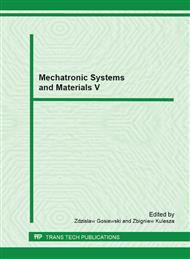[1]
D.J. Morton, Structural factors in static disorders of the foot, Amer. J. Surg. 19 (1930) 315-326.
Google Scholar
[2]
C.J. Lin, K.A. Lai, T.S. Kuan, Y.L. Chou, Correlating factors and clinical significance of flexible flatfoot in preschool children, J Pediatr Orthop. 21 (2001) 378-382.
DOI: 10.1097/01241398-200105000-00022
Google Scholar
[3]
W.W. Lovell, C.T. Price, P.L. Meehan, The Foot, Pediatric Orthopaedics, 2nd edition, Philadelphia, 1986, p.895–977.
Google Scholar
[4]
J.B. Volpon, Footprint analysis during the growth period, J Pediatr Orthop 14 (1994) 83–85.
Google Scholar
[5]
J.V. Basmajian, C.J. Deluca, Muscle Alives. Williams & Wilkins, Baltimore 1985, p.310–353.
Google Scholar
[6]
K. Penneau, L.D. Lutter, R.B. Winter, Pes planus radiographic changes with foot orthoses and shoes, Foot Ankle 2 (1982) 299–303.
DOI: 10.1177/107110078200200508
Google Scholar
[7]
D.R. Wenger, S. Diego, et al., Corrective shoes and inserts as treatment for flexible flatfoot in infants and children, J Bone Joint Surg. 71A (1989) 800–810.
DOI: 10.2106/00004623-198971060-00002
Google Scholar
[8]
J. Pauk J., V. Ezerskiy, The effect of foot orthotics on arch height: prediction of arch height correction in flat-foot children, Biocybernetics and Biomedical Engineering 31 (2011) 51-62.
DOI: 10.1016/s0208-5216(11)70005-5
Google Scholar
[9]
J. Pauk, Modelling and prognosis flat feet parameters in children, Monograph, Bialystok University of Technology 207, (2011).
Google Scholar
[10]
M. Kolasa, R. Dlugosz, J. Pauk, A comparative study of different neighborhood topologies in WTM Kohonen self-organizing maps, Solid State Phenomena 147-149 (2009) 564-569.
DOI: 10.4028/www.scientific.net/ssp.147-149.564
Google Scholar
[11]
T.J. Cole, M.C. Belizzi, K.M. Flegal, W.H. Dietz, Establishing a standard definition for child overweight and obesity worldwide, Br Med J. 320 (2000) 1–6.
Google Scholar
[12]
R.G. Nielsen, M.S. Rathleff, O.H. Simonsen, H. Landberg, Determination of normal values for navicular drop during walking: a new model correcting for foot length and gender, Journal of Foot and Ankle Research (2009) 2-12.
DOI: 10.1186/1757-1146-2-12
Google Scholar
[13]
K.C. Kowalski, P.R.E. Crocker, R.A. Faulkner, Validation of the Physical Activity Questionnaire for Older Children, Pediatric Exercise Science 9 (1997) 74-186.
DOI: 10.1123/pes.9.2.174
Google Scholar
[14]
J.R. Landis, G.G. Koch, The measurement of observer agreement for categorical data, Biometrics 33 ( 1977) 159—174.
DOI: 10.2307/2529310
Google Scholar
[15]
Z.W. Ras, A. Wieczorkowska, Action-Rules: How to increase profit of a company, in Principles of Data Mining and Knowledge Discovery, Proceedings of PKDD 2000, France, LNAI, 1910, Springer (2000) 587-592.
DOI: 10.1007/3-540-45372-5_70
Google Scholar
[16]
Z.W. Ras and A. Dardzinska, Action Rules Discovery Based on Tree Classifiers and Meta-actions, in Proceedings of the 18th International Symposium on Foundations of Intelligent Systems, Czech Republic (2009) 66-75.
DOI: 10.1007/978-3-642-04125-9_10
Google Scholar


